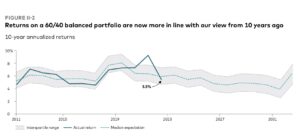
’Tis the Season for economic forecasts. Further to the Vanguard 2023 outlook highlighted on the Hub yesterday comes various forecasts from Franklin Templeton Investments and its sub-advisors.
The selections below suggest Recession is the most likely scenario for 2023 — something Vanguard also forecast — and ClearBridge Investments sees Infrastructure assets as more promising than global equities during this period. Clearbridge runs the Franklin Clearbridge Sustainable Global Infrastructure Income Active ETF. See also this blog on Infrastructure investing from BMO ETFs, which ran on the Hub late in August.
As with Monday’s blog, we’ve highlighted relevant paragraphs directly from the horse’s mouth, including the subheadings from the various money managers. Unless otherwise indicated, images are from our image banks.
ClearBridge Investments: U.S. economic outlook by Investment Strategist Jeff Schulze
Recession is the path of least resistance
As we look ahead to 2023, recession has gone from a distantly possible scenario to the most probable one, and the potential pivot by the Fed that many equity investors are hoping for is unlikely to occur.
Our views are grounded in the reading of the ClearBridge Recession Risk Dashboard of 12 economic indicators, which has been flashing red for the past four months, indicating a recession. Eight of the 12 underlying indicators are signaling recession, including traditional recession precursors, like the 10- year/3-month Treasury yield curve, which inverted this fall. This portion of the yield curve has correctly anticipated the last eight recessions dating back to 1970, providing an average of 11 months of warning.

A recession is not a done deal, however. The most likely positive path involves what we have dubbed the “immaculate slackening” where the labor market tightens but not too many jobs are lost. Job openings are still more than 3 million above their pre-pandemic level (but down 1.5 million from the peak), while the total number of persons employed is only around 1 million greater than before COVID-19. This suggests room exists to loosen labor demand but not destroy as many jobs, which would help restore balance and ease wage gains. Importantly, this could help ease inflation, particularly in service industries where wages are a larger component of prices.
The most important factor to achieve a soft landing is a substantial reduction in inflation, which would allow the Fed to back off its aggressive actions. With inflation unlikely to return to 2% in 2023, and the labor market proving resilient, the Fed is likely to continue to tighten monetary policy to slow the economy and curb price increases, which will ultimately result in a recession. Monitoring the health of the labor market will be important in the coming year, given its role as a key inflation barometer for the Fed. We will also be looking for signs of weakening consumption outside of the most interest rate sensitive areas as evidence that a slowdown is taking deeper root.
ClearBridge Investments: Global infrastructure outlook by Portfolio Managers Charles Hamieh, Shane Hurst and Nick Langley
Infrastructure earnings more secure than global equities; U.S. expected to focus on renewables
From no growth in 2020 to rapid growth in 2021 to slow growth in 2022, we look at 2023 with a base case of recessions in the U.S., Europe and the U.K.
The impact on infrastructure, though, should be muted, particularly for our regulated assets, where the companies generate their cash flows, earnings and dividends from their underlying asset bases, as we expect those asset bases to increase over the next several years. As a result, infrastructure earnings look better protected compared to global equities.

Most infrastructure companies have a link to inflation in their revenue or returns. Regulated assets, such as utilities, have their regulated allowed returns adjusted for changes in bond yields over time. As real yields rise, utilities look poised to perform well, and we have currently tilted our infrastructure portfolios to reflect this.
As a result, the underlying valuations of infrastructure assets are relatively unaffected by changes in inflation and bond yields. However, we have seen equity market volatility associated with higher bond yields impact the prices of listed infrastructure securities, making them more compelling when compared with unlisted infrastructure valuations in the private markets.
On top of its relative appeal versus equities, infrastructure should benefit from several macro drivers in 2023 — and beyond. First, energy security is driving policy right now, and a significant amount of infrastructure will need to be built to attain energy security. High gas prices and supply constraints brought on by the Russia/Ukraine war have highlighted the importance of energy security and energy investment. This is supportive of energy infrastructure, particularly in Europe, where additional capacity is needed to supplant Russian oil and gas supply, and in the U.S., where new basins are starting up, in part to meet fresh demand from Europe. Continue Reading…








